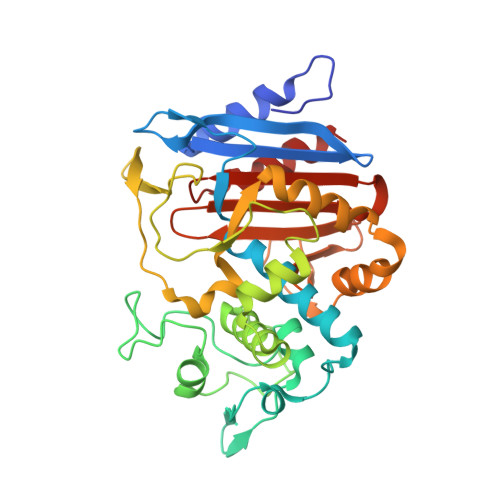Analysis of Structure-Function Relationships in the Colibactin-Maturating Enzyme ClbP.
Cougnoux, A., Gibold, L., Robin, F., Dubois, D., Pradel, N., Darfeuille-Michaud, A., Dalmasso, G., Delmas, J., Bonnet, R.(2012) J Mol Biology 424: 203-214
- PubMed: 23041299
- DOI: https://doi.org/10.1016/j.jmb.2012.09.017
- Primary Citation of Related Structures:
4GDN - PubMed Abstract:
pks genomic island of Escherichia coli is involved in the synthesis of the non-ribosomal peptide-type genotoxin colibactin, which has been suggesting as affecting the host immune response and having an impact on cancer development. The pks-encoded enzyme ClbP is an atypical peptidase that contributes to the synthesis of colibactin. In this work, we identified key features of ClbP. Bacterial fractionation and Western-blot analysis revealed the docking of ClbP to the bacterial inner membrane via a C-terminal domain harboring three predicted transmembrane helices. Whereas only one helix was necessary for the location in the inner membrane, the complete sequence of the C-terminal domain was necessary for ClbP bioactivity. In addition, the N-terminal sequence of ClbP allowed the SRP/Sec/YidC- and MreB-dependent translocation of the enzymatic domain in the periplasmic compartment, a feature also essential for ClbP bioactivity. Finally, the comparison of ClbP structure with that of the paralogs FmtA-like and AmpC revealed at an extremity of the catalytic groove a negative electrostatic potential surface characteristic of ClbP. Site-directed mutagenesis experiments identified in this zone two aspartic residues that were important for ClbP bioactivity. Overall, these results suggest a model for precolibactin activation by ClbP and pave a way for the design of inhibitors targeting colibactin production.
- M2iSH, INSERM U1071, INRA USC2018, Clermont Université, Université d'Auvergne, 63000 Clermont-Ferrand, France.
Organizational Affiliation:

















